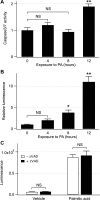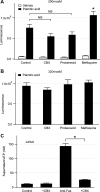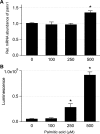Pannexin1 contributes to pathophysiological ATP release in lipoapoptosis induced by saturated free fatty acids in liver cells
- PMID: 22972801
- PMCID: PMC3492830
- DOI: 10.1152/ajpcell.00175.2012
Pannexin1 contributes to pathophysiological ATP release in lipoapoptosis induced by saturated free fatty acids in liver cells
Abstract
Hepatocyte lipoapoptosis induced by saturated free fatty acids (FFA) contributes to hepatic inflammation in lipotoxic liver injury, and the cellular mechanisms involved have not been defined. Recent studies have shown that apoptosis in nonhepatic cells stimulates ATP release via activation of pannexin1 (panx1), and extracellular ATP functions as a proinflammatory signal for recruitment and activation of the inflammatory cells. However, it is not known whether lipoapoptosis stimulates ATP release in liver cells. We found that lipoapoptosis induced by saturated FFA stimulated ATP release in liver cells that increased extracellular ATP concentration by more than fivefold above the values observed in healthy cells. This sustained pathophysiological ATP release was not dependent on caspase-3/7 activation. Inhibition of c-Jun NH(2)-terminal kinase (JNK), a key mediator of lipoapoptosis, with SP600125 blocked pathophysiological ATP release in a dose-dependent manner. RT-PCR analysis indicated that panx1 is expressed in hepatocytes and multiple liver cell lines. Notably, inhibition of panx1 expression with short hairpin (sh)RNA inhibited in part pathophysiological ATP release. Moreover, lipoapoptosis stimulated uptake of a membrane impermeable dye YoPro-1 (indicative of panx1 activation), which was inhibited by panx1 shRNA, probenecid, and mefloquine. These results suggest that panx1 contributes to pathophysiological ATP release in lipoapoptosis induced by saturated FFA. Thus panx1 may play an important role in hepatic inflammation by mediating an increase in extracellular ATP concentration in lipotoxic liver injury.
Figures










Similar articles
-
Lipoapoptosis induced by saturated free fatty acids stimulates monocyte migration: a novel role for Pannexin1 in liver cells.Purinergic Signal. 2015 Sep;11(3):347-59. doi: 10.1007/s11302-015-9456-5. Epub 2015 Jun 9. Purinergic Signal. 2015. PMID: 26054298 Free PMC article.
-
Free fatty acids induce JNK-dependent hepatocyte lipoapoptosis.J Biol Chem. 2006 Apr 28;281(17):12093-101. doi: 10.1074/jbc.M510660200. Epub 2006 Feb 27. J Biol Chem. 2006. PMID: 16505490
-
Pannexin1 channels act downstream of P2X 7 receptors in ATP-induced murine T-cell death.Channels (Austin). 2014;8(2):142-56. doi: 10.4161/chan.28122. Epub 2014 Mar 3. Channels (Austin). 2014. PMID: 24590064 Free PMC article.
-
The role of pannexin1 in the induction and resolution of inflammation.FEBS Lett. 2014 Apr 17;588(8):1416-22. doi: 10.1016/j.febslet.2014.03.009. Epub 2014 Mar 15. FEBS Lett. 2014. PMID: 24642372 Free PMC article. Review.
-
Exciting and not so exciting roles of pannexins.Neurosci Lett. 2019 Mar 16;695:25-31. doi: 10.1016/j.neulet.2017.03.010. Epub 2017 Mar 8. Neurosci Lett. 2019. PMID: 28284836 Free PMC article. Review.
Cited by
-
Revisiting multimodal activation and channel properties of Pannexin 1.J Gen Physiol. 2018 Jan 2;150(1):19-39. doi: 10.1085/jgp.201711888. Epub 2017 Dec 12. J Gen Physiol. 2018. PMID: 29233884 Free PMC article. Review.
-
Lipoapoptosis induced by saturated free fatty acids stimulates monocyte migration: a novel role for Pannexin1 in liver cells.Purinergic Signal. 2015 Sep;11(3):347-59. doi: 10.1007/s11302-015-9456-5. Epub 2015 Jun 9. Purinergic Signal. 2015. PMID: 26054298 Free PMC article.
-
Transport of charged small molecules after electropermeabilization - drift and diffusion.BMC Biophys. 2018 Mar 21;11:4. doi: 10.1186/s13628-018-0044-2. eCollection 2018. BMC Biophys. 2018. PMID: 29581879 Free PMC article.
-
Purinergic Signalling: Therapeutic Developments.Front Pharmacol. 2017 Sep 25;8:661. doi: 10.3389/fphar.2017.00661. eCollection 2017. Front Pharmacol. 2017. PMID: 28993732 Free PMC article. Review.
-
Inhibitors of connexin and pannexin channels as potential therapeutics.Pharmacol Ther. 2017 Dec;180:144-160. doi: 10.1016/j.pharmthera.2017.07.001. Epub 2017 Jul 15. Pharmacol Ther. 2017. PMID: 28720428 Free PMC article. Review.
References
-
- Belfort R, Harrison SA, Brown K, Darland C, Finch J, Hardies J, Balas B, Gastaldelli A, Tio F, Pulcini J, Berria R, Ma JZ, Dwivedi S, Havranek R, Fincke C, DeFronzo R, Bannayan GA, Schenker S, Cusi K. A placebo-controlled trial of pioglitazone in subjects with nonalcoholic steatohepatitis. N Engl J Med 355: 2297– 2307, 2006 - PubMed
-
- Bunse S, Locovei S, Schmidt M, Qiu F, Zoidl G, Dahl G, Dermietzel R. The potassium channel subunit Kvbeta3 interacts with pannexin 1 and attenuates its sensitivity to changes in redox potentials. FEBS J 276: 6258– 6270, 2009 - PubMed
MeSH terms
Substances
LinkOut - more resources
Full Text Sources
Research Materials
Miscellaneous

